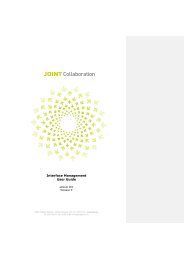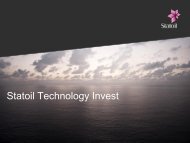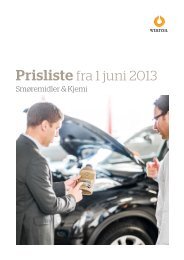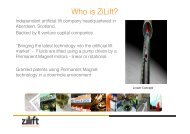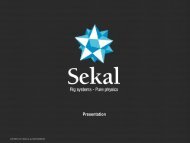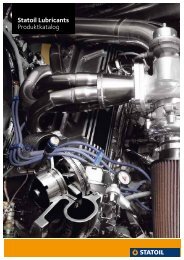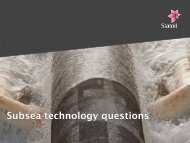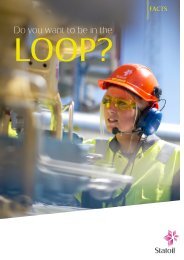Ida Ekblad MarIus Engh anawana haloba lars lauMann - Statoil
Ida Ekblad MarIus Engh anawana haloba lars lauMann - Statoil
Ida Ekblad MarIus Engh anawana haloba lars lauMann - Statoil
You also want an ePaper? Increase the reach of your titles
YUMPU automatically turns print PDFs into web optimized ePapers that Google loves.
Over the years its state of abandon – which may be considered<br />
the exact opposite of the non-place concept of French<br />
anthropologist Marc Augè – suggested various new uses for the<br />
hill, including a hotel complex and meditation centre.<br />
Such a concentration of events, according to the artist,<br />
brings the very concept of ruin into discussion. The objects that<br />
belonged to this place and bore witness to its history are so<br />
charged with memory that they may be considered saturated<br />
and returned to nature, thereby absolving the last function left<br />
to them, as custodians of memory and a vehicle for healing.<br />
Photography, in <strong>Engh</strong>’s creative universe, is an investigative<br />
narrative form which the artist uses to relate time and history,<br />
keeping track in a single image of the different moments and<br />
different events that have characterised places and objects,<br />
enabling us to achieve a new perspective. <strong>Engh</strong>’s work, which<br />
inevitably becomes the protagonist of this narrative process, is<br />
seen in an archaeological perspective that tends to examine the<br />
various stratifications involved and their spirit.<br />
His art pushes far beyond a simple, albeit intense,<br />
documentation of the place and its scenarios towards a full grasp<br />
of the subjects of his quest. <strong>Engh</strong> does this by creating clones<br />
of the original, thereby establishing new points of view and new<br />
conceptions of the “things” that belong to reality and experience.<br />
This process of re-creation of what is real is an evident<br />
attempt to scan precisely the spirit and history that objects<br />
carry with them, as well as a simultaneous attempt to abstract<br />
them from their original context and exhibit them in fresh<br />
circumstances by seeking out their unexpressed potential.<br />
By reproducing objects taken from everyday life and highlighting<br />
some of their formal aspects, <strong>Engh</strong> achieves a transposition of<br />
the meaning of the chosen subject, managing to shift attention<br />
in a simple gesture from historical and “archaeological” detail to<br />
formal detail, assimilating these objects – even if in this stage<br />
of <strong>Engh</strong>’s artistic process it would be better to define them as<br />
forms – into artistic currents such as Minimalism.<br />
This mode leads the artist, through interpretation of the<br />
meanings and functions that objects have inherited over time,<br />
towards the attainment of their essential form. In this way, the<br />
object is stripped of all its acquired superstructures and we are<br />
left with the form itself, which provides us with an opportunity to<br />
60<br />
reflect on the systematic and standardised aspects of daily life.<br />
Observers thus find themselves faced by pure form that has<br />
lost the characteristic of giving or withholding information, to<br />
become an abstract concept and synthesis of itself. This opens<br />
up for a series of different and diversified interpretations that<br />
re-adapt the reality to which the object refers.<br />
The displacement that the artist manages to create between<br />
the initial input and the formal result is particularly evident in<br />
one of his latest shows: Lycanthropic Chamber. The monster<br />
(the werewolf referred to in the title) seems to have completely<br />
disappeared from the scene, leaving hardly a trace. The works<br />
on show seem to be innocuous geometric forms that once again<br />
echo Minimalism and Modernism. Where is the ferocious beast,<br />
this slave to the full moon, with its characteristically dramatic<br />
and fearful howls? In which of the essential and dry forms of<br />
works such as Pinstripes (2008) – a triangular steel grid where<br />
different geometric motifs are repeated; or Hotel California<br />
(2008) – a wall comprising two semi-transparent sheets making<br />
that which appears behind the partition seem as if wrapped in a<br />
slight mist, is the lycanthrope hiding?<br />
The image suggested by the title of the exhibition is in reality<br />
a metaphor of wildness, of the slave to passions who regresses<br />
to the primitive nature of his origins, a metaphor of Man<br />
enacting violence against others, of the sadism and masochism<br />
latent in human nature.<br />
An essential and summary example is the work entitled<br />
Gulfstream V 1–4 (2007): four framed documents,<br />
complemented with four almost identical images of the aircraft<br />
mentioned in the title and four signatures at the bottom.<br />
The work was inspired by a news item in the Washington<br />
Post about the way in which some prisoners of war from<br />
Afghanistan and Iraq are taken to US bases in countries<br />
where the US legal system is not applied, thereby allowing<br />
for methods of interrogation other than those envisaged<br />
by US legislation. All data about the prisoners and the<br />
people involved in transport is false or can only be traced to<br />
anonymous mail boxes. The transformation of the individual<br />
from subject to object is total; the elimination of his identity<br />
sums up the capacity of Man, through self-negation, to merge<br />
with his brutal nature.





